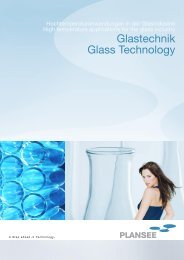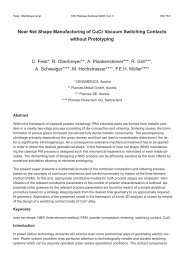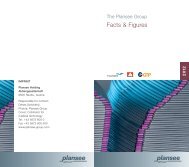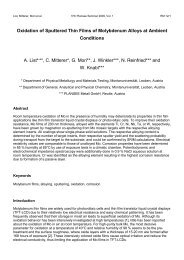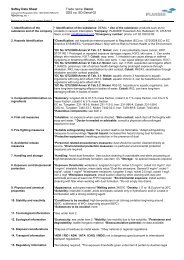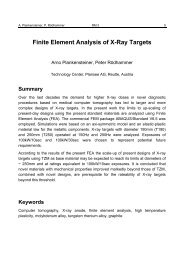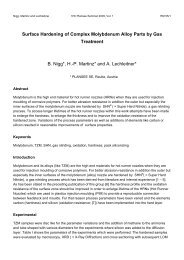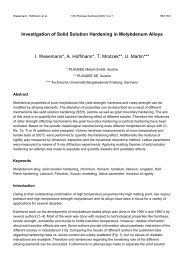PROPERTIES OF THE SIBOR® OXIDATION PROTECTIVE - Plansee
PROPERTIES OF THE SIBOR® OXIDATION PROTECTIVE - Plansee
PROPERTIES OF THE SIBOR® OXIDATION PROTECTIVE - Plansee
Create successful ePaper yourself
Turn your PDF publications into a flip-book with our unique Google optimized e-Paper software.
H.P. Martinz et al. RM 7 83<br />
differently composed borosilicate glasses can attack and dissolve SIBOR-Mo much<br />
faster.<br />
4. CONCLUSIONS<br />
The Si-B-C oxidation protective coating was applied to tungsten - , TZM - ,<br />
molybdenum – 3 vol. % zirconia and molybdenum - samples by APS (= Atmospheric<br />
Plasma Spraying) and partly with a subsequent heat treatment (SIBOR ® ).<br />
Some of the coated samples were submitted to ramp oxidation tests with heating rates<br />
of 10°C / hour up to a temperature of 1450°C and subsequent dwelling for 24 hours.<br />
This procedure simulates the heating up of a glass melting tank where SIBOR ® coated<br />
parts are most frequently used. SIBOR ® coated Mo – ZrO2 behaved almost identically<br />
as standard coated SIBOR ® / Mo and could therefore be used in cases of higher creep<br />
load. TZM also can be protected by SIBOR ® coating with potential applications in the<br />
molten aluminum process technology. SIBOR ® on W does not work because of the<br />
different properties of W oxides.<br />
As coated, heat treated and partly oxidized Mo samples were immersed into various<br />
molten glasses to determine the dissolution behaviour of the SIBOR ® substrate<br />
system. This simulates the situation when the glass melting tank is filled and operated<br />
with molten glass. SIBOR ® / Mo is most easily dissolved by the alkali and fluoride rich<br />
opal glass; next is the alkali rich soda lime glass with a slightly lower reactivity.<br />
Borosilicate glass with the lowest alkali content of the glasses being tested reacts only<br />
slowly with the SIBOR ® / Mo system. In no case the coating could be completely<br />
dissolved within one week. Bubbles and discolouration can be found in the glass in all<br />
cases even after this period. So it depends on the time scale of the production start<br />
and the glass specifications concerning bubbles and discolorations if SIBOR ® - coated<br />
Mo parts can be used.<br />
References<br />
[1] H.-P. Martinz, J. Matej, G. Leichtfried, Proceedings of the 15th <strong>Plansee</strong> Seminar,<br />
Reutte, 2001, pp. 217 – 228.<br />
[2] H.-P. Martinz, J. Matej, M. Sulik, Proceedings of the 12th Conference on electric<br />
and other highly efficient ways of glass melting, Tabor, 2001, pp. 71 – 81.



